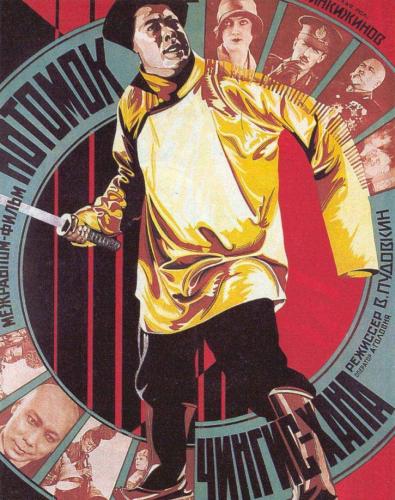
Storm Over Asia (originally called Потомок Чингисхана—’The Heir to Ghengis Khan’, 1928) was screened at Whitney Humanities Center on Wednesday, October 25, as a part of the year-long series commemorating the centennial of the Russian Revolution. This time the audience was taken not to Russia but to Mongolia, 1920, where they witnessed the struggle between the British occupants and Red partisans. The main character of the film, a local hunter named Bair, joins the partisans but is soon captured by the British. An ancient document that proves his being the heir to Ghengis Khan’s saves his life as the British plan to make him a puppet king of Mongolia. After recovering from his wounds, however, Bair regains consciousness and rebels against his masters. He finally gains his own voice (he was a truly silent character of a silent film, not pronouncing a single word): the subaltern learns to speak, and the Storm comes to sweep the ancien régime.
It should be mentioned that the plot has very little to do with the actual history of Mongolia. Although British interventionists were present in that region during the Civil War, they never played such a significant role as attributed to them by the film. In fact, Mongolia was invaded by the Russian White Army led by Baron R.F. von Ungern-Sternberg who, after fighting Chinese forces there, was finally driven out of the country by Bolsheviks. As Professor John MacKay claims in his notes for the film, the British here provide ‘a kind of generic view of colonialism and colonial types, rather than a real historical account.’ Anti-capitalism equals anti-imperialism, and vice versa.
The screening was followed by a discussion between Professor MacKay and Professor Katerina Clark. Professors talked about the differences between the film and Ivan Novokshonov’s novella it was based upon (in fact, the novella was published only in 1965, but Osip Brik, the screenwriter, took the idea from his friend Novokshonov and collaborated with him while writing the script). Of course, Marxist ideas were discussed, such as the concept of fetishism as ‘commodity fetishism’: a beautiful pelt of a fox captured by Bair is extremely important to the plot and is present throughout the film. As the audience noted, Storm over Asia also suggests a possible symbolist reading, which would be especially interesting to do considering that the famous symbolist painter and philosopher Nicholas Roerich was traveling through Mongolia exactly at the time when the film was being shot. The discussion also touched upon such issues as the ethnographic aspect of Storm over Asia and the influence of avant-garde abstract film on Pudovkin’s work.
The film was accompanied by Donald Sosin, resident pianist for the Film Society of Lincoln Center, BAM, and the Museum of Moving Image. Sosin also worked as a resident film accompanist at the Museum of Modern Art. He composes music for silent films himself, and his work includes scores for The Cabinet of Dr. Caligari, Nosferatu, A Story of Floating Weeds, Blind Husbands, and many others. He will return to Yale for three more films: Aelita, Queen of Mars (November 1), Fall of the Romanov Dynasty (November 8), and Fragment of an Empire (November 29).
The series Red Century: Russian Revolution on Film is sponsored by the Russian Studies Program at the European Studies Council at the MacMillan Center; Whitney Humanities Center; and the Edward J. and Dorothy Clarke Kempf Memorial Fund. For information on upcoming screenings, visit: http://europeanstudies.macmillan.yale.edu/calendar
Written by Mariia Muzdybaeva, ER&S Master’s Degree student

